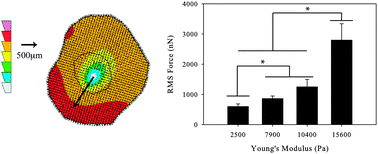Macrophage motility is driven by frontal-towing with a force magnitude dependent on substrate stiffness†
Abstract
The ability of macrophages to properly migrate is crucial to their success as early responders during the innate immune response. Furthermore, improper regulation of macrophage migration is known to contribute to several pathologies. The signaling mechanisms underlying macrophage migration have been previously studied but to date the mechanical mechanism of macrophage migration has not been determined. In this study, we have created the first traction maps of motile primary human macrophages by observing their migration on compliant polyacrylamide gels. We find that the force generated by migrating macrophages is concentrated in the leading edge of the cell – so-called frontal towing – and that the magnitude of this force is dependent on the stiffness of the underlying matrix. With the aid of chemical inhibitors, we show that signaling through the RhoA kinase ROCK, myosin II, and PI3K is essential for proper macrophage force generation. Finally, we show that Rac activation by its GEF Vav1 is crucial for macrophage force generation while activation through its GEF Tiam1 is unnecessary.


 Please wait while we load your content...
Please wait while we load your content...